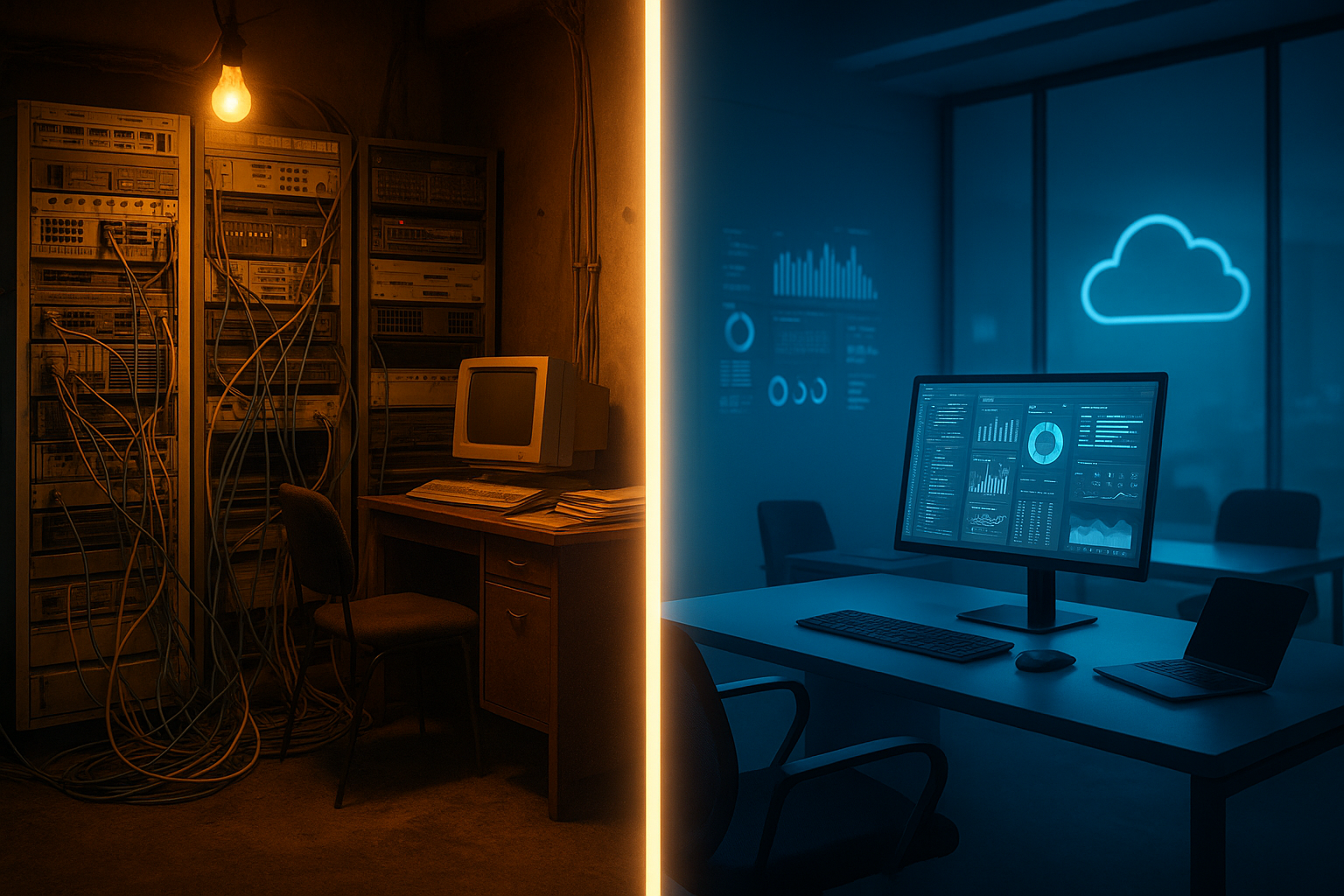Cloud ERP vs On Premise ERP: When Is the Right Time to Move to Cloud ERP?
ERP software is the backbone of financial and project visibility in construction and engineering. But as your firm grows, the systems that once worked can start holding you back.
If you’re running an older, on-premise ERP, or still managing projects with spreadsheets, you’re likely already feeling the strain: disconnected field teams, manual reconciliations, and rising IT costs.
That’s why many firms are asking the same question: WHEN is the right time to move to the cloud?
For growing firms, the answer often comes down to scalability, visibility, and cost. Cloud ERP gives you the freedom to expand without expensive hardware, deliver real-time insights to your teams, and eliminate the IT burden that comes with maintaining servers.
At ReviveERP, we specialize in helping construction and engineering firms through this transition. As an exclusive Acumatica partner, we’ve helped dozens of project-based businesses modernize their systems, streamline workflows, and future-proof operations.
Contact us today to learn more or schedule a demo.

When Legacy ERP Starts Holding You Back
Many firms begin with an on-premise ERP because, years ago, it was the only option. But as the industry evolves, those same systems often struggle to keep up with new demands.
You might notice warning signs like:
- IT overhead growing faster than your projects
- Manual reconciliations slowing down reporting
- Field teams unable to access data in real time
- Costly downtime every time an upgrade is required
These challenges are signs that your technology is capping your firm’s potential. On-premise systems once gave companies control, but now they create silos, delay decisions, and demand constant maintenance.
At some point, the cost of staying put outweighs the cost of modernizing. That’s when firms turn to cloud ERP to reclaim visibility, efficiency, and control.
Why New Firms Skip On-Premise Altogether
For firms implementing ERP for the first time, the choice is much simpler. There are very few reasons to invest in on-premise ERP today.
Cloud ERP offers everything a growing firm needs without the upfront capital, hardware, or dedicated IT staff. It’s faster to deploy, easier to maintain, and scales as you grow. And with modern vendors like Acumatica, your data security, uptime, and compliance are often stronger than what most firms can achieve on their own servers.
Simply put: on-premise ERP is legacy technology, cloud ERP is the future. It’s where construction and engineering firms can unify financials, projects, and field operations under one secure, accessible system.
What Are the Two Types of ERP?
When people ask about cloud ERP vs on-premise ERP, they’re usually referring to deployment options. In reality, there are two main types:
- Cloud ERP – Hosted on vendor servers and accessed online. Updates, backups, and security are handled for you.
- On-Premise ERP – Installed on your company’s servers. Your IT team manages hardware, updates, and security.
For construction and engineering firms, the common path is starting with on-premise and eventually migrating to the cloud once the limitations of legacy systems become too costly.

What Is the Difference Between Cloud and On-Premise ERP?
At its core, the difference comes down to where your ERP system lives and who maintains it.
Cloud ERP is hosted on secure vendor-managed servers, meaning updates, backups, and compliance are handled for you. It runs on a predictable subscription model with lower upfront costs and automatic updates included.
In contrast, on-premise ERP is installed on your company’s own servers, which requires in-house IT staff to manage hardware, security patches, and upgrades. This typically comes with higher initial investment, ongoing maintenance costs, and downtime whenever updates are needed.
Cloud ERP also scales more easily—unlimited users, regions, or modules can be added instantly without expanding infrastructure—while on-premise systems are limited by your physical server capacity.
And because cloud ERP is accessible from any device, anywhere, it supports remote teams far better than traditional on-site systems that rely on office-based VPNs.
Ultimately, the hosting model determines everything from cost to usability and security, which is why more firms are shifting toward cloud-based solutions.
Pros and Cons of On-Premise ERP
Advantages
- Control – Full ownership of data and hardware.
- Customization – Easier to tailor for highly specific workflows.
Disadvantages
- High IT costs – Hardware, security patches, and backup all fall on your team.
- Slow upgrades – Each upgrade requires downtime and budget.
- Limited mobility – Remote access is clunky and often unreliable.
For many engineering firms, this means staying stuck on legacy ERP, and that can result in missed revenue from poor change order tracking, delays in consolidating project data, and costly IT overhead.
Pros and Cons of Cloud ERP
Advantages
- Lower upfront costs – No hardware purchases required.
- Built-in security – Compliance, backups, and encryption handled by the vendor.
- Scalability – Add new entities, regions, or users without major IT projects.
- Remote access – Project managers, field crews, and CFOs see the same data in real time.
Challenges
- Data control concerns – Some leaders worry about handing data storage to a vendor.
- Internet dependence – A reliable connection is necessary.
For construction firms with field teams, the benefits far outweigh the challenges. Cloud ERP means real-time approvals, change order visibility, and dashboards that keep projects on track.
The Business Case for Cloud ERP
When the time comes to modernize, the question isn’t just which ERP, it’s which model will best support your growth over the next decade?
For construction and engineering firms, cloud ERP offers a clear advantage. It delivers the same powerful functionality as on-premise systems but without the infrastructure, maintenance, or downtime. And because it’s built to scale, your system grows right alongside your business.
Here’s why more firms are moving to the cloud every year:
- Mobile field access
Supervisors and project managers no longer need to wait until they’re back in the office to update the system. With cloud ERP, they can approve time sheets, purchase orders, and change orders right from the job site, keeping projects moving without delays.
- Real-time dashboards
CFOs and operations leaders can track project profitability instantly. Instead of waiting for manual reconciliations or end-of-month reports, they see live dashboards that reflect up-to-the-minute costs, revenue, and margins across every project.
- Workflow automation
Acumatica Cloud ERP includes built-in AI assistants and workflow tools that simplify day-to-day tasks. Approvals, reporting, and compliance checks happen automatically, reducing manual work and freeing up staff to focus on higher-value tasks.
- Stronger security
Unlike legacy ERP systems that leave firms responsible for patching and backups, Acumatica delivers enterprise-grade security. Customers maintain ownership of their own data, while private AI models ensure confidentiality and compliance across industries.
This is why cloud ERP advantages now outweigh on-premise ERP disadvantages, especially for growing construction and engineering firms.

Making the Right Choice for Your Firm
When comparing ERP deployment options, ask:
- Do we have the IT staff to maintain servers, patches, and backups?
- How quickly are we growing (new regions, new companies, new projects)?
- Do field teams and remote staff need better real-time access?
- How important is predictable, subscription-based pricing vs capital outlay?
Most construction and engineering firms are finding that the cost of doing nothing and sticking with legacy ERP is higher than the cost of modernizing. Cloud ERP benefits like scalability, mobility, and stronger financial visibility are too valuable to ignore.
At ReviveERP, we guide firms through ERP modernization with tailored construction and engineering editions of Acumatica. From approval workflows to dashboards and KPIs, we configure the system around how your firm actually works.
Ready to modernize your ERP? Book a cloud ERP demo with ReviveERP.







